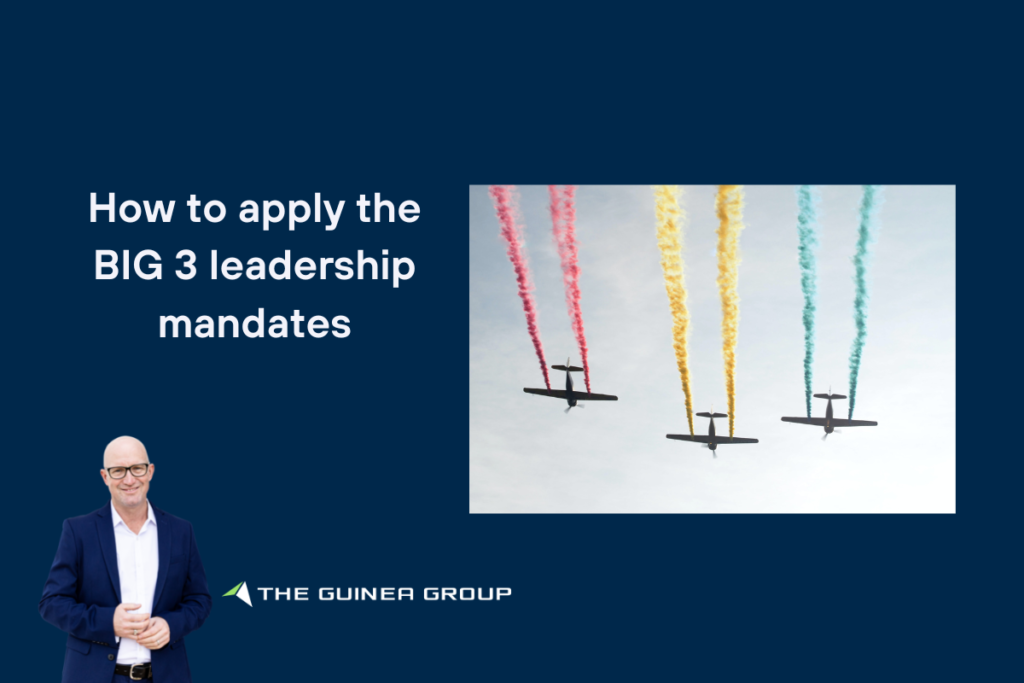Anton Guinea
Entrepreneur, Speaker, bestselling author, and founder of The Guinea Group of Companies. For over 15 years, Anton has helped leaders move their teams to become psychologically safe, physically safe and overall better versions of themselves.

How to apply the BIG 3 leadership mandates

Leadership can be challenging. It can be rewarding. After parenting, it is the most important job on planet earth (sorry first responders, and teachers). And it takes a range of skills and experiences to get it right.
But sitting above the skill sets of leaders are a set of three mandates. The definition of a mandate is an order or being commissioned to do something. The three leadership mandates are the obligations of leaders, from the day that they take on a leadership role. And the mandates relate in this order, a mandate to the organisation, a mandate to the team, and a mandate to the self. Also known as values, transformation, and control (VTC).
Mandate One: Values Alignment
Here is the background to this mandate. The organisational focused mandate.
When leaders (particularly senior leaders) leave organisations, especially when they have had a long tenure with that organisation, the comment that they make (and that I hear in my coaching) is that: “My values don’t align with the values of the business”.
This is code for, the business has asked me to do something, to say something, to decide something that doesn’t feel right… on a very deep level. Now, yep… let’s slow it down a little at this point – I get that leaders sometimes must support organisational decisions and make those decisions their own. Understood. But there are times when, for the leader, this requirement violates a deep personal value.
So, the mandate for a leader is to be firstly very clear on their own set of 3 values. The most common leadership value is integrity. Your might be different. Mine personally are energy, engagement, and enterprise thinking. I have a purpose that sits above those values (my why) which is to leave humans and businesses better than I found them.
Yours might be respect, teamwork, or any of the multitude of other values that could drive your behaviour. And that is why values are the very first mandate. “Research finds that individual values are a driving force behind personal responsibility” (Mirvis and Googins, 2010). Again, your values drive your behaviour. They are the first things that you turn to when it comes to making big decisions.
And here’s the thing, 90% of leaders (that we train and deal with at least) have never done a values exercise. They have never done the work to understand what their personal values are.
Just Google a values list, and see what words come up, and what resonates for you. Then compare your list to the values of your organisation.
And then most importantly, understand if your values align with their organisation’s values. If they don’t, that is cool, you may be able to find a way to reconcile that with yourself. If you can’t, it will be difficult to stay in your organisation.
An understanding and alignment of values is a big thing for leaders. That is why it is mandate number one. When you are being values driven, you can then step into transformational leadership.
Mandate Two: Transformational Leadership
Here is the background to this mandate, the team and human focused mandate.
In 1978, James Burns published the seminal work on transformational leadership in the book simply titled ‘Leadership’. According to Burns, transforming leadership is a process in which “leaders and followers help each other to advance to a higher level of morale and motivation”.
In short, here is a very quick way to sum up the concept of being a transformational leader. And that is to ‘create more leaders’. A leader’s role is to work with those in their team, to provide them with the coaching, the mentoring, the training and any other opportunity for growth that they need to become even better future leaders. Leaders who also understand these three mandates.
And, yes, I hear you again. Not all our team members want to advance their careers into more senior roles. And some think that they should be progressing faster than they really should. With every mandate comes a quandary. And this is the quandary for leaders, who and how to develop more leaders.
There is one way to find out, and that is to have career conversations. Not performance discussions, not mid-year reviews, but career conversations. Conversations that talk through what the team member values (see mandate one), and what they want to do with their working life. For more information on this one, see the book, Radical Candor, by Kim Scott. Some of your team might want to own a hobby farm in the future. And wouldn’t it be good if you could equip them with the leadership skills to make that happen. While they are in your team and growing and producing more for your business now.
In your team, you have rock starts and super stars (credit: Kim Scott). Rock stars want to be high performers now, and don’t want to progress (so let’s not force them to). Super stars want to progress (so let’s understand what this progression looks like). And that progression might be quicker than you think it should be, as their leader. Some super stars are just committed to their career growth… and please presume positive intent here. It will be for the right reasons.
I get the career focus. As a young leader, there was no way I was going to slow down and back off on my goals. I had them in a Project Gannt Chart and was totally committed to progressing through the ranks. And I had leaders who supported that. Finally, I got promoted to middle level management (too young, and too early), and I was working for a human without conscious control – zero personal control. And that is why I do what I do now, so that leaders are better equipped than that leader was. To stay in conscious control.
Mandate Three: Created Conscious Control
Here is the background to this mandate, the self (and situation) focused mandate.
It has long been known, even before we could study the human brain with high powered technology, that the human has two thinking and behavioural pathways. One could be called the primitive, or the instinctive… or the emotional… pathway. The other would be called the thinking, the reasoning, or the rational pathway.
In other words, we have an instinctive and a reasoning pathway for making decisions, and that drive our behaviour. The instinctive pathway is routed through the amygdala, in the limbic system, which controls our emotional responses, and our fight or flight response. The reasoning pathway is routed through our frontal lobes, the parts of our brain which make us uniquely human, and which allow us to plan and make rational decisions.
Daniel Kahneman called these system 1 and 2 processes, in his book ‘Thinking Fast and Slow’. In 1924, Fredrick Mathias Alexander published (which was at the time very progressive) the book ‘Constructed Conscious Control of the Individual’. My favourite quote from that book is:
“I do not know of any person who doubts that if people are to evolve in the right direction, the gap between the instinctive and conscious control of the self must be bridged”.
Stop for a moment and reread that quote. That was written in 1924. In other words, the human must have control of self. And yes, it is still as relevant now as it was nearly one hundred years ago. Here at TGG, we call it ‘created conscious control’. And conscious leadership (a more contemporary term).
Created conscious control is about emotional control, behavioural control, and situational control. And for every leader on planet earth, this is a key mandate. To remain in control, regardless of what is happening.
Is that possible, of course not.
But is it an obligation of leadership? Absolutely.
There are only three things that drive our behaviour, and they are our beliefs (subconsciously), our values (consciously – see mandate one), and our emotional state. And if you don’t think our emotions drive our behaviour, just watch an angry person.
And see what damage people do to other humans, and to their own reputation, when they act on emotion, rather than on reasoning.
This mandate is the self-mandate because it is incumbent upon leaders to have conscious control. Without conscious control, leaders don’t have behavioural control, and without behavioural control, leaders have zero chance of having situational control. And with leaders being under so much pressure, they need to be able to manage high pressure situations and high stress encounters. That is the job at times.
When leaders let their emotions drive their behaviours, and when those emotions are out of control, they hurt other humans. And if they are not on the dark triad (google it), they will apologise for their behaviour, and make the excuse that it was just because of their emotional state (uncool).
This is what some leaders don’t understand – the hurt that leaders cause humans will be remembered for decades. How do I know, because I ask people in our coaching and training programs for the leader conversation or conversations that hurt their hearts. Some can remember those conversations from 10, 20, or 30 years ago.
Knowing this, why not be the leader who is in control, and who is remembered for being in conscious control, not being remembered as the leader who didn’t have that control. Creating conscious control can be learnt, it is a skill. It is a set of behaviours, habits, and patterns that a leader runs to keep their frontal lobes oxygenated, and in charge of the situation. See Daniel Goleman’s work on Emotional Intelligence for more information on staying in emotional control.
So, there you have it. The BIG THREE leadership mandates, and why they are important.
Yes, these are simple to say. Not as easy to implement. But worth it.
Could you please do me a favour, and share this with leaders everywhere? It really is that important, for leaders to understand what their mandates are.
And of course, please click the image below if you’d like to chat about what leadership means to you.
If you would like to learn more about Anton or The Guinea Group, please click here to book into Anton’s calendar, to:
UPGRADE your Mindset
UPSKILL your Leadership
UPLIFT your Teams
About Anton
Anton has dedicated his working life to helping leaders to upgrade their mindset, upskill their leadership, and uplift their teams! With a focus on helps leaders to better lead under pressure. Anton is an entrepreneur, speaker, consultant, bestselling author and founder of The Guinea Group. Over the past 19 years, Anton has worked with over 175+ global organisations, he has inspired workplace leadership, safety, and cultural change. He’s achieved this by combining his corporate expertise, education (Bachelor of HR and Psychology), and infectious energy levels.
Work With Anton!
Sources
https://www.simplypsychology.org/stress-management.html
Subscribe to our Newsletter
